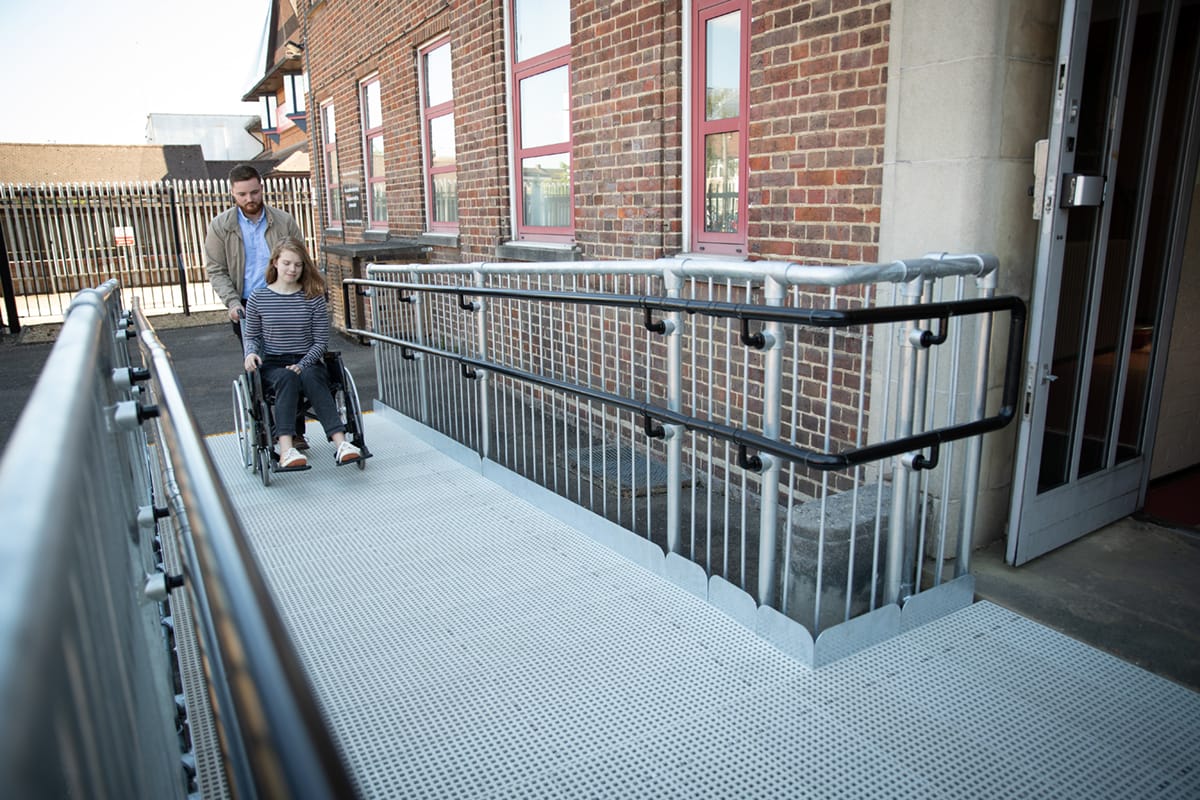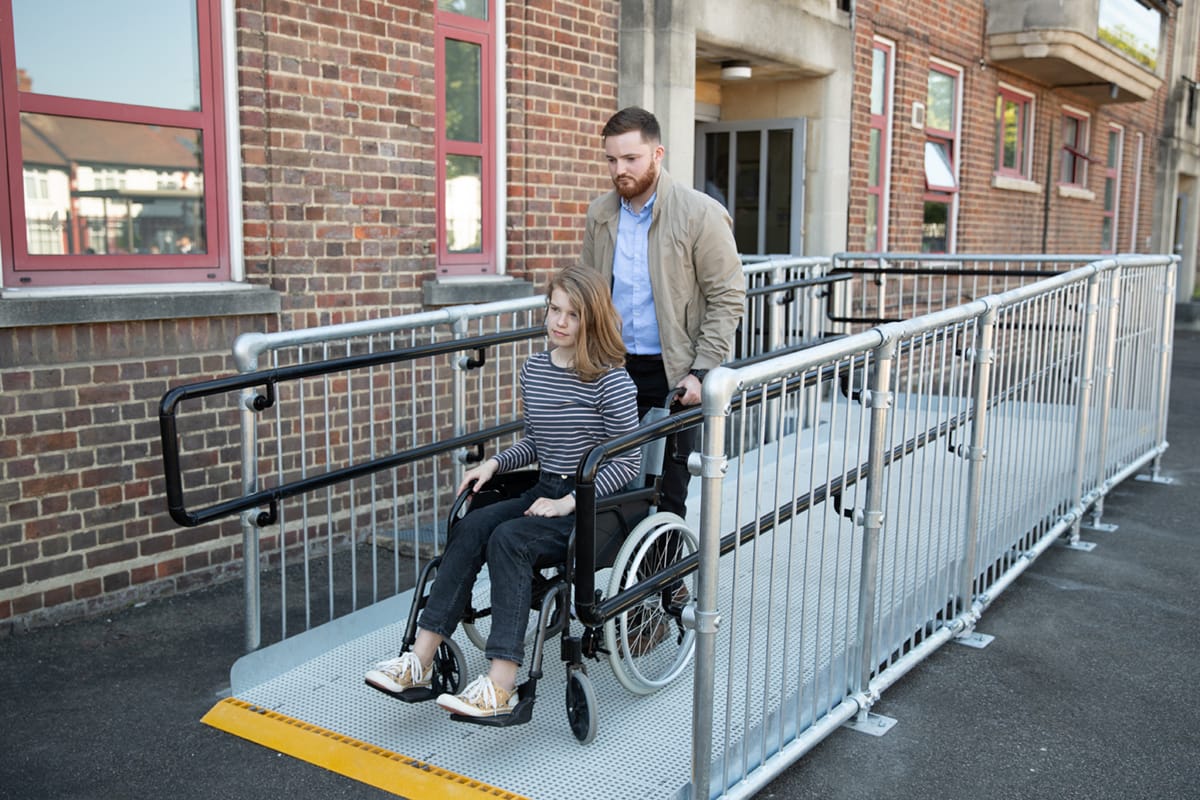Choosing the Right Ramp
Why Modular May Be the Smarter Investment

Matthew Brown is the Strategic Business Development Manager at FlexDecks.
Accessibility is a crucial consideration for residential, commercial, and mixed-use properties thanks to the Americans with Disabilities Act (ADA), signed into law 35 years ago in 1990. Major renovations require at least 60% of public entrances to be accessible (ADA 206.4.1) and entrances are the most visible compliance risk for most buildings. It’s important to get that right with the correct ramp, stair, and landing design, and compliance to local and national standards like the ADA and International Building Code (IBC) enhances property value and improves tenant satisfaction, while minimizing risk for the business.
Historically, ADA and IBC entrances have been designed and built using traditional methods like timber, concrete, and custom metal fabrication. This approach can suffer from expensive design and QA resources to deliver consistent, high-quality results. Skilled labour and variable field conditions will slow down construction and often require build times of weeks or months to complete.


Modular ADA egress stairs.
Challenges of Traditional Construction
Traditional construction methods are time consuming. It is labor intensive with little room for automation or concurrent work schedules, so trying to move faster only introduces more problems like safety and quality risks along with an increased likelihood of costly mistakes. Limited control over schedules means limited control over costs, with slow build times adding significant labor costs.
Labor is also specialized, with tradespeople constructing or fabricating at the site. These trades are costly and rightfully so — the skills needed are difficult to get and can produce some amazing results. The problem is that some aspects of construction simply do not need that level of ability in the field and asking general labor to do the same task introduces significant risk to the quality of the result.
Controlling the onsite environment is limited, affecting quality, speed, and even safety. Weather conditions can wreak havoc on the most meticulous plans, even with well-prepared contingencies to protect building materials and schedules. Traffic, pedestrians, other local construction, and even political activity can hamper schedules and disrupt progress, adding significant cost to the project. Safety on a construction site is deadly serious — OSHA reports 1069 construction fatalities in 2022.
Compliance with safety standards is already difficult and delivering a safety and/or compliance-based scope of work becomes even more challenging to deliver in real world conditions. OSHA, IBC, ADA, NEC — the codes may be clear, but construction of a solution with many onsite variables adds risk to the result and a potentially costly inspection cycle.
Finally, layers of approval and review are needed for fabricated, traditional construction building components. This is critically important as the design is new every time and the work must be meticulously controlled to deliver the expected result for the Owner. Documentation must be organized and trustworthy, adding further risk as multiple parties get involved.


Modular ADA ramp for public access.
Benefits of Modular Construction
Modular construction solves these problems directly, and the goal is still the same — we want a quality, reliable structure that meets the functional requirements and satisfies compliance. Modular entrance systems offer flexible design parameters and integrated engineering to provide a reliable and compliant result. Design loads are easily calculated thanks to offsite construction of all components, and all requirements will be considered to deliver peace of mind. Even late-stage changes can be accommodated with rapid redesign and deployment of modular components.
Installation for most configurations can be done in days, not weeks or months. Mechanical assembly requires only common labor and hand tools, and components are manufactured in a controlled environment following standard processes that deliver reliable quality. Unexpected conditions can be solved with in-stock, standard components instead of a costly and time-consuming redesign.
Conclusion
Modular construction offers a compelling alternative to traditional methods for designing and building ADA and IBC-compliant entrances. By addressing the challenges of traditional construction, such as time-consuming processes, unavailable specialized labor, and variable field conditions, modular solutions provide a more efficient, cost-effective, and reliable approach. The benefits of modular construction, including flexible design parameters, rapid installation, and consistent quality, make it an attractive option for property owners and managers seeking to enhance accessibility and compliance while minimizing risks.
More from Modular Advantage
Resia: Breaking All the Rules
Resia Manufacturing, a division of U.S.-based Resia, is now offering prefabricated bathroom and kitchen components to industry partners. Its hybrid fabrication facility produces more precise bathroom and kitchen components (modules) faster and at lower cost than traditional construction. Here’s how Resia Manufacturing does it.
How LINQ Modular Innovates to Bring Modular To The Market in the UAE and Beyond
LINQ Modular, with an office and three manufacturing facilities in Dubai, is a modular firm based in United Arab Emirates. The company is on a mission: to break open the housing and construction markets in the Gulf Cooperation Council (GCC) area with modular.
ModMax: Redefining Modular Construction with Confidence and Precision
ModMax was born out of frustration—frustration with five persistent pain points in modular construction: Permitting bottlenecks. Production delays. Rigid designs. Disconnect between “the office” and the field. Lack of transparency and communication.
LifeArk: Disaster-Resilient Housing from Recycled Plastic and 100-year-old Technology
Wee compares LifeArk’s housing units to Yeti coolers, as they are built similarly. Each component takes 15 to 20 minutes to manufacture, has an R-value of 40, and includes molded slots and chases for wiring, plumbing, fire sprinklers, and other utilities.
Building the Future of Modular Edge Infrastructure
The edge data center market is expanding rapidly, driven by the surge in AI workloads, IoT adoption, and the need for localized compute power. In these environments, sustainability, scalability, and reliability are non-negotiable. Cooling is among the most complex challenges for operators—and one of the most decisive factors in long-term success.
Accelerating Light-Gauge Steel Construction: A Semi-Automated Digital Workflow for Off-Site Projects
For construction professionals, the message is clear. By adopting semi-automation and digitalization, companies can deliver projects faster, more accurately, and more profitably, while also building stronger collaboration across teams. The approach is not about replacing people with machines, but about empowering people with better tools and processes.
Why Modular Data Centers Are Gaining Momentum
Artificial intelligence, high-performance computing, and edge applications push the limits of traditional “stick-built” data centers. They take years build, often struggle with high density workloads, and aren’t optimized for deployments near end users. Modular data center platforms are purpose-built to address these challenges, offering flexibility and scalability to adapt to evolving technologies, while opening new opportunities for the modular construction industry.
Supply Chain Innovation in Action: 5 Habits Every Modular Leader Should Practice
By applying these principles to supply chain practices — collaborative planning, strategic procurement, scenario modeling, digital tools, and transparent forecasting — construction leaders can build value chains that are not just efficient and agile, but truly innovative.
Exploring the Role of Modular Integrated Construction (MiC) in Advancing Circular City Principles – A Survey of Stakeholder Perspectives
The survey findings highlight the significant potential of Modular integrated Construction (MiC) in advancing the development of circular cities. By reducing costs, accelerating construction timelines, and minimizing waste generation, MiC offers a promising approach to sustainable urban development.
The Use of MS POLYMER™-Based Sealants and Adhesives in Modular Building
These products combine flexibility and elastic recovery with excellent adhesion to different substrates and have already shown their usefulness in traditional construction. Now it’s time for them to be put to use in the modular construction industry.










